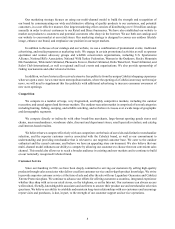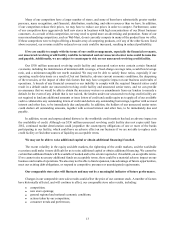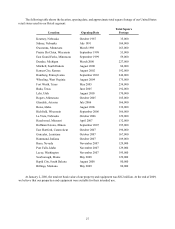Cabela's 2009 Annual Report Download - page 27
Download and view the complete annual report
Please find page 27 of the 2009 Cabela's annual report below. You can navigate through the pages in the report by either clicking on the pages listed below, or by using the keyword search tool below to find specific information within the annual report.18
distribution center also processes returns. Any natural disaster or other serious disruption to these centers due to fire,
tornado, or any other calamity could damage a significant portion of our inventory and materially impair our ability
to adequately stock our retail stores, deliver merchandise to customers, and process returns to vendors and could
result in lost revenue, increased costs, and reduced profits.
Our historic sales tax collection policy for our Direct business may subject us to liabilities for unpaid
sales taxes on past Direct business sales.
Many states have attempted to require that out-of-state direct marketers, whose only contacts with the state
are solicitations and delivery to their residents of products purchased through the mail or the Internet, collect sales
taxes on the sale of these products. In addition, a private litigant, purportedly on behalf of various states, has initiated
litigation against several out-of-state direct marketers alleging that the failure to collect and remit sales tax violates
various state false claims laws. The U.S. Supreme Court has held that states, absent congressional legislation, may
not impose tax collection obligations on out-of-state direct marketers unless the out-of-state direct marketer has
nexus with the state. Nexus generally is created by the physical presence of the direct marketer, its agents, or its
property within the state. Our sales tax collection policy for our Direct business is to collect and remit sales tax in
states where our Direct business has established nexus. Prior to the opening of a retail store, we historically sought
a private letter ruling from the state in which the store would be located as to whether our Direct business would
have nexus with that state as a result of the store opening. Some states have enacted legislation that requires sales
tax collection by direct marketers with no physical presence in that state. In some instances, the legislation assumes
nexus exists because of the physical presence of an affiliated entity engaged in the same line of business. During the
first quarter of 2008, we received an assessment for unpaid sales taxes on prior Direct business sales from a state
with such legislation. It is also possible that we may receive future assessments from other states for unpaid sales
taxes on prior Direct business sales. We presently intend to vigorously contest the assessment and any future sales
tax assessments, but we may not prevail. If we do not prevail with respect to any assessment, we could be held liable
for sales taxes, plus interest and penalties, on prior Direct business sales, which could be substantial.
Taxation risks could subject us to liability for past sales and cause our future Direct business sales to
decrease.
A number of states have been considering or adopted initiatives that require Internet retailers operating
“affiliate programs” in the state to collect sales tax on the retailer’s sales to residents in these states. We believe
that affiliate programs do not create nexus with a state and that these initiatives are inconsistent with the U.S.
Supreme Court’s holding that states, absent congressional legislation, may not impose tax collection obligations on
out-of-state direct marketers unless the out-of-state direct marketer has nexus with the state. If these initiatives are
successful, we could be required to collect sales taxes in additional states. The imposition by state governments of
sales tax collection obligations on out-of-state direct marketers who participate in Internet commerce could create
administrative burdens for us, put us at a competitive disadvantage if they do not impose similar obligations on our
competitors, and decrease our future Direct sales.
We must successfully order and manage our inventory to reflect customer demand and anticipate changing
consumer preferences and buying trends or our revenue and profitability will be adversely affected.
Our success depends upon our ability to successfully manage our inventory and to anticipate and respond
to merchandise trends and customer demands in a timely manner. We cannot predict consumer preferences with
certainty and they may change over time. We usually must order merchandise well in advance of the applicable selling
season. The extended lead times for many of our purchases may make it difficult for us to respond rapidly to new or
changing product trends or changes in prices. If we misjudge either the market for our merchandise or our customers’
purchasing habits, our revenue may decline significantly and we may not have sufficient quantities of merchandise to
satisfy customer demand or we may be required to mark down excess inventory, either of which would result in lower
profit margins. In addition, as we implement our retail store expansion strategy, we will need to construct additional
distribution centers or expand the size of our existing distribution centers to support our growing number of retail
stores. If we are unable to find suitable locations for new distribution centers or to timely integrate new or expanded
distribution centers into our inventory control process, we may not be able to deliver inventory to our retail stores in a
timely manner, which could have an adverse effect on the revenue and cash flows of our Retail business.
























